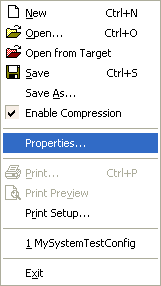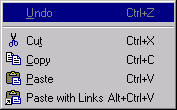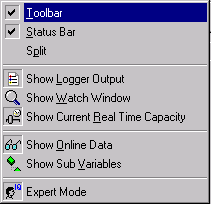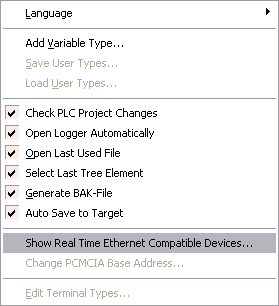Main Menus
The controls, more precisely the menu bar and the toolbar (symbol bar) of the TwinCAT System Manager are described below.
The menu bar comprises the following six options:
File, Edit, Actions, View,Options and ?(Help).
Where present, the toolbar icons are displayed next to their corresponding menu entries.

The title bar shows the name of the currently loaded TwinCAT System Manager project or "Unnamed" if a new project has not yet been saved under a name.
The standard Windows controls also appear in the right-hand corner of the title bar:
 Moves the System Manager to the task bar without closing the project
Moves the System Manager to the task bar without closing the project
 /
/  Adjusts the System Manager view to small or full screen display (Minimize / Maximize).
Adjusts the System Manager view to small or full screen display (Minimize / Maximize).
 Exits / closes the TwinCAT System Manager.
Exits / closes the TwinCAT System Manager.
 | Not all menu entries are active at all times As the TwinCAT System Manager is context-sensitive, not all menu entries are active at all times! |
”File” menu

New 
Creates a new System Manager project (blank configuration).
Open 
Opens a dialogue for the selection of an existing saved System Manager project.
Open Currently Active 
Opens the project file whose configuration is currently active in the TwinCAT system.
Save 
Saves the current configuration in a TwinCAT System Manager *.wsm file (respectively *.tsm file under TwinCAT 2.9).
Save As
Saves the current configuration in a *.wsm file with user-defined name and location.
Hint:
At TwinCAT version 2.9, a new file format (Structured Storage) was implemented for saving of TwinCAT System Manager configurations. This new file format gets the file extension *.tsm.
Alternatively, also under TwinCAT 2.9, configurations can be opened from WSM-files or saved into files with *.wsm extension. To achieve this, the appropriate extension is to be selected at "Save as type:" in the "Save As.." dialog.
 | New file format From TwinCAT 2.9, a newly implemented format (Structured Storage) is used by default to save the system configuration. This new file format has the extension .tsm. Alternatively, WSM files can still be read in under TwinCAT 2.9, or newly created configurations can be saved with the file extension *.wsm. To do this, simply select the appropriate file extension in the "Save as..." selection dialog. |
Enable Compression
To be lenient with the limited resources on devices of the CX1000 and BXxxxx classes, an optional compression feature for saving of *.tsm configurations has been implemented at TwinCAT 2.9.
"Enable Compression" is activated by default and achieves, depending on the project, a space saving of 80% and more.
Properties
Under this new menu item at TwinCAT 2.9, extended document information regarding the System Manager project can be found and edited.
Print 
Opens Printing dialog if high-lighted. Printable section required.
Print Preview
Presents view of the selected window which is prepared for printing (depending upon selected area of the System Manager).
Printer Set-up
Opens the printer settings dialogue box.
Exit
Closes the TwinCAT System Manager.
”Edit” menu

Undo
Reverses the last action.
Cut 
Copies selected object to the clipboard and removes it from the current configuration.
Copy 
Copies selected object to the clipboard.
Paste 
Inserts elements from the clipboard to the current position.
Insert with links 
Inserts elements with present link from the clipboard into the current position.
 | All are not always available Not all of the above functions are available in every context. |
”Actions” menu

Check Configuration 
Checks the current configuration for plausibility.
Activates configuration 
Saves and activates the current configuration. This function can be selected from the Command line without opening the System Manager.
 | New backup location for configuration data From version TwinCAT 2.8, the project-related configuration data is no longer saved in the Windows Registry, but in a newly introduced XML file with the name "CurrentConfig.xml". This file can be found in the subdirectory: \TwinCAT\Boot. |
Starting/restarting TwinCAT in run mode
Starts or restarts the TwinCAT system with the currently saved configuration. From TwinCAT version 2.9, this button is also used to switch from CONFIG to RUN mode. In addition, a possibly configured PLC boot project is loaded and started if "Auto Boot" is activated (see also the description:TwinCAT system -> User interface -> TwinCAT system control ). This function can be selected from the Command line without opening the System Manager.
 | Target system From TwinCAT 2.9, this button is used to start the TwinCAT target system selected via "Choose Target System" with the currently loaded configuration (by default, the target system is always the local PC). The ADS-AMSNetID and the name of the currently selected target system machine (TwinCAT PC, CX1000 or other TwinCAT target system) is displayed in the lower right corner of the System Manager. If the target system is the local PC, the name "Local" is displayed instead of the network name. If the currently selected target is a remote system, its name is also displayed in the title bar. The current mode is indicated in the lower right corner of the System Manager window, as well as additionally by means of a color change at the TwinCAT system control (in this case to the color green). |
Start/restart TwinCAT in config mode
This remote configuration option (also called "remote configuration") is new with TwinCAT version 2.9. It switches the TwinCAT system into config mode. This functionality is required, among other things, in order to be able to configure devices of the Beckhoff CX1000 class, for example, which do not have the TwinCAT System Manager locally (see also: "Choose Target System"). The current mode or status is displayed on the far right in the lower corner of the System Manager window, and, for a local target system, by means of a color change on the TwinCAT system control (in config mode, for example, this is the color blue).
Reload Devices
Rescans the I/O configuration at the selected target system and displays it in the System Manager tree view.
Choose Target System 
With this item you can select the appropriate target system, where the configuration must be made for (see also:"Set/Reset TwinCAT to Config Mode").
Read Target Server Versions
Reads the current TwinCAT server versions available on the prior selected target system.
Update Bus Coupler/IP Link Firmware
Updates the Firmware of Beckhoff Bus Couplers or Fieldbus Boxes through serial COM port.
Access Bus Coupler/IP Link Register 
The user can access any available register at a Bus Coupler or Fieldbus Box module via COM port or TCP/IP address after entering the necessary information in the upcoming dialog.
Export XML Description
Saves the configuration data of the currently highlighted tree item as a XML Description file to disk.
Import XML Description
Imports the configuration data of a previously saved XML Description file into the current System Manager configuration.
Check Variable Links
Validates the current mapping information.
”View” menu

Toolbar
Displays or hides the tool bar.
Status Bar
Displays or hides the status bar. The status bar is displayed at the lower edge of the main window.
Split
Activates a movement off a dividing line between the tree view and the dialogues in the System Manager main window.
Show Current Real Time Capacity 
Displays/removes the real time load of the (starting) TwinCAT system in the lower right-hand corner of the main window.
Show Online Data 
Displays/removes the online data of the configured variables. The current configuration for a display must be active, i.e. saved, in the registry and the TwinCAT system must be started.
Show Sub Variables 
Displays the sub-variables of variables.
Show Expert Mode 
Displays or removes seldom used parameters for various settings dialogues in the System Manager.
”Options” menu

Language
Opens the selection menu to select one of the languages supported by the TwinCAT System Manager.
 | Languages If the other languages are grayed out, the System Manager has found the corresponding DLLs, but they are not up-to-date. |
Check PLC Project Changes
If this option is selected, a message box appears when saving configuration changes to PLC projects. This message box requests the PLC Configuration to be re-loaded in.
Open Logger Automatically 
Automatically opens the Logger Window when System Manager is started and displays current TwinCAT events.
Open last Used File
Automatically opens the last saved *.wsm file when System Manager is started.
Select Last Tree Element
Automatically opens the last saved display of the configuration tree.
Generate BAK-File
When this option is selected a ”Current Name”.bak file is created as a backup file with each saving.
Auto Save to Target
When this option is selected, additionally to the local system the configuration is also saved to the target system (e.g. when configuring a CX1000 or BXxxxx). By default, the configuration is saved in a zipped version. See also: "Enable Compression".
Change PCMCIA Base Address
Opens settings dialogue to change the PC Card base address. After making changes it is necessary to restart Windows.
”Help” menu (?)

Help Topics 
Opens the TwinCAT System Manager Help files. Help is a part of the Beckhoff Information System. If you require an English version of Help, you need to install the English language Beckhoff Information System.
Help Context 
When the Beckhoff Information System is installed, opens the Help page relating to the area selected in the System Manager.
About TwinCAT System Manager 
Calls up information about the current installed version of the TwinCAT System Manager.
Other switching elements on the tool bar
Find
Opens device search dialog within the System Manager.
Device search
If you have selected the entry "I/O Devices" (below I/O - Configuration) in the tree view on the left, a device search function can be triggered via the toolbar button shown here. The first step is to start searching for supported I/O devices and – if these are found – then continue with the search for connected devices ("boxes") and their terminal equipment, or IP link extension modules.
 | This functionality is only implemented universally from TwinCAT 2.9. To be able to run it, the target system must be in config mode. (The current mode is displayed in the lower right corner of the main window.) |
Change free run status 
After activating this button, with a target system in config mode, supported I/O devices can be set to free run mode. I/O variables of bus terminals can then also be written without configured and activated task (e.g. without PLC project).
 | If the target system was previously in run mode, the button "Reloading the I/O devices" (reloading the configuration) in the toolbar must be pressed once to be able to set the I/O devices to free run mode. |
Full expand tree below selected item 
After pushing this button, the entry marked in the TreeView will be shown in the fully expanded view.
